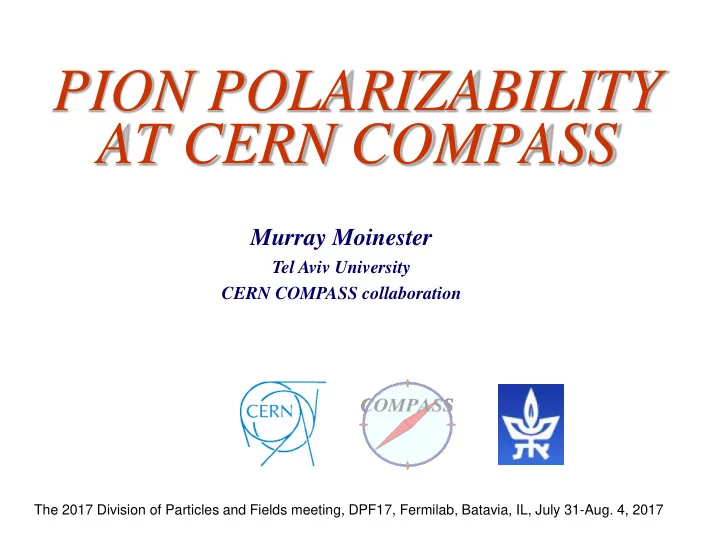

PION POLARIZABILITY AT CERN COMPASS Murray Moinester Tel Aviv University CERN COMPASS collaboration The 2017 Division of Particles and Fields meeting, DPF17, Fermilab, Batavia, IL, July 31-Aug. 4, 2017
COMPASS NA58 experiment at CERN SPS COmmon Muon and Proton Apparatus for Structure and Spectroscopy 20 Institutes/11 counties/~230 physicists Czech Republic, Finland, France, Germany, India, Israel, Italy, Japan, Poland, Portugal and Russia Bielefeld, Bochum, Bonn, Burdwan/Calcutta, CERN, Dubna, Erlangen, Freiburg, Lisbon, Mainz, Moscow, Munich, Prage, Protvino, Saclay, Tel Aviv, Torino, Trieste, Warsaw and Yamagata
Dipole pion polarizabilities probe rigidity of pion’s quark - antiquark structure. Dipole moments induced by gamma’s electric and magnetic fields during Gamma-Pion Compton scattering: d= α E μ = β H.
Compton Scattering Polarizability or π− ρ 0
Primakoff scattering (pion Bremsthalung) of 200 GeV π from virtual photon target is a hypo-peripheral one-photon exchange reaction. Illustrate via production of a 1 (1260), mass m a , followed by a 1 →πγ . Target Z intact with low recoil energy , no FSI , separated from large p T meson exchange reactions . Minimal 4-momentum transfer t 0 to Z. For m a =1 GeV, p π = 200 GeV/c, t 0 =5x10 -6 GeV/c 2 , p T,min = 2 MeV/c . Uncertainty Principle: b p T,min = π /2 and b ~ 150 fm .
Experimental pion polarizabilities subject chiral symmetry and PT techniques of QCD to serious tests. Major failure - PT predicts pion polarizability significantly stiffer than previous measurements, and most other models. At one-loop level, electric and magnetic polarizabilities equal and opposite. Two-loop corrections small. Predictions below.
Polarizabilities are associated with the Rayleigh scattering cross section of sunlight photons on atomic electrons in atmospheric N 2 and O 2 . The oscillating electric field of sunlight photons forces the atomic electrons to vibrate. The resulting changing electric dipole moment radiates energy as the square of it second derivative. The radiated power is P ~ α 2 λ -4 , where α is the electric polarizability of the atom. The scattering cross section depends on λ -4 . The intensity of scattered and transmitted sunlight is therefore dominated by blue and red, respectively. The daytime sky is therefore blue, while sunrise and sunset are red .
http://virgo-physics.sas.upenn.edu/events/primakoff.html
The COMPASS Experiment Two-stage spectrometer • large angular acceptance • broad kinematical range • ~250000 channels • > 800 TB/year Data taking periods: 2002- 2004: 160 GeV/c m + • 2004: 2 weeks 190 GeV/c p - MuonWall • 2006-2007: 160 GeV/c m + • 2008-2009: 190 GeV/c p, p - SM2 E/HCAL E/HCAL SM1 Dipole magnets MuonWall Target Tracking detectors RICH RICH Beam El.-mag. calorimeter Hadronic calorimeter [hep-ex/0703049, NIM A 577, 455 (2007)] Muon identification
et al.
2015, 4.0 ± 1.2 ± 1.4
et al., Mainz
THE RICH DETECTOR photon 5 m detectors C 4 F 10 • radiator gas: C 4 F 10 • mirror wall: 20 m 2 surface • photon-detectors: • outer part (75%) MWPC(pad RO) with CsI cathode • inner part(25%) 576 MAPMTs with indiv. telescope threshold momenta Installed in 2005, ● p p = 2 GeV/c Used in data taking from 2006 ● p K = 9 GeV/c ● p P =17 GeV/c
The Compass Spectrometer
Trigger Experimental conditions during the 2004 hadron run (7 days) • Beam: 190 GeV/c; ~10 6 π /s, 4.8 s / 16 s spill structure 190 GeV/c; ~10 8 μ /s • Targets: 1.6 – (2+1) - 3 mm Pb , 7 mm Cu, 23 mm C • Triggers: • Primakoff 1 = Hodoscope hit x ECal2 (E>50 GeV) x HCal2 (E>18 GeV) • Primakoff 2 = ECal2 (E>100 GeV) • Saturated trigger rate (40-50k/spill)
Pion Polarizability, Radiative Transitions, and Quark Gluon Plasma Signatures Can one expect gamma ray rates from the QGP to be higher than from the hot hadronic gas phase. Xiong, Shuryak, Brown (XSB) calculate photon production from a hot hadronic gas via the reaction π− + ρ 0 → a 1 (1260 ) → π − + γ. For a 1 (1260 ) → πγ, they assume a radiative width of 1.4 MeV. XSB use their estimated a 1 radiative width to calculate the pion polarizability, obtaining α π = 1.8 × 10 − 43 cm 3 . Independently, Holstein showed that meson exchange via a pole diagram involving the a 1 resonance provides the main contribution (α π = 2.6 × 10 − 43 cm 3 ) to the polarizability. New Primakoff data for π − γ → a 1 (1260 ) → π− ρ 0 should allow a reevaluation of the consistency of their expected relationship, and improved calculation of the gamma rate from the hot hadronic gas phase.
From Holstein & Scherer
Other models (dispersion sum rules, QCD sum rule, lattice calculations,…) predict different polarizability values: 0<( α π + β π )<0.39; 3.2<( α π - β π )<11.2 According to ChPT, the pion is significantly stiffer than shown by previous measurements, and most other models.
Recommend
More recommend